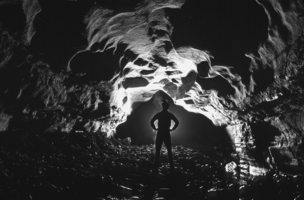 | Back to e-WV
| Back to e-WV
 The West Virginia Encyclopedia
The West Virginia Encyclopedia
 | Back to e-WV
| Back to e-WV
 The West Virginia Encyclopedia
The West Virginia Encyclopedia

Natural caves are found throughout eastern and southeastern West Virginia. Most West Virginia caves are formed by the dissolving of soluble rocks (primarily limestone and dolomite) by ground water. West Virginia caves typically have a year-round temperature of about 52 degrees and a relative humidity close to 100 percent. Caves have been extensively studied as part of geologic, biologic, and hydrologic investigations. They are an important recreational resource.
The first full report on West Virginia caves was by William E. Davies and was published in 1949 by the West Virginia Geological and Economic Survey. Organ Cave was described as early as 1837. The private West Virginia Speleological Survey currently maintains records on West Virginia caves. ‘‘New’’ caves are discovered as cavers search the limestone areas of the state, so the number of known caves continues to grow.
Based on the most recent data, the total number of caves reported in West Virginia is 4,241. Many of these are quite small; the number of caves with lengths or depths of 33 feet or more was 1,810. Only 106 caves have more than one mile of surveyed passage. The five longest caves in West Virginia are Friars Hole (Greenbrier and Pocahontas counties), 44 miles; Organ Cave (Greenbrier), 40 miles; The Hole (Greenbrier), 23 miles; Scott Hollow (Monroe), 22 miles; and Culverson Creek Cave (Greenbrier), 21 miles. The neighboring counties of Greenbrier, Pocahontas, Pendleton, Randolph, and Monroe have by far the greatest number of reported caves. Together they account for 2,977 caves, more than three-fourths of all West Virginia caves.
Cave soils are high in nitrates and were used by early settlers in the home manufacture of black powder. Soils from some West Virginia caves were mined as early as 1776. Organ Cave was apparently mined during the War of 1812 and during the Civil War. The Confederacy was desperate for gunpowder and established elaborate mining and extraction efforts to recover nitrates in numerous caves during the Civil War. At least 22 West Virginia caves were mined for saltpeter (potassium nitrate) during the Civil War. The best preserved saltpeter mining operation in West Virginia is in Organ Cave. Caves were considered to be natural bomb shelters during the Cold War, and civil defense signs were placed near numerous caves. Supplies were cached in a few, but they quickly deteriorated under the damp conditions typical of most West Virginia caves.
Caves represent an important natural resource. Many unique animals specifically adapted to life in the total darkness of caves are found throughout the limestone areas of the state. A single cave may represent the only known location for an organism, and several West Virginia caves are protected by the Nature Conservancy to provide a safe habitat for a variety of animals. Common cave animals from West Virginia include bats, salamanders, cave crickets, beetles, and a variety of cave-adapted invertebrates such as amphipods and isopods. No snakes are known to live in West Virginia caves.
Scientific research on West Virginia caves has been conducted by students and professors from many different colleges and universities. Several cave clubs or ‘‘grottos’’ of the National Speleological Society are located in West Virginia. Caves are a fragile environment protected by state law. No collecting of rock or mineral samples or animals is permitted. Most West Virginia caves are located on private property and should be entered only with permission of the landowner. Cave exploring can be a dangerous sport and should be learned in the company of experienced cavers with the proper equipment. Several caves are open to the public for guided tours, including Lost World Caverns (Greenbrier), Organ Cave (Greenbrier), Smoke Hole Caverns (Grant), and Seneca Caverns (Pendleton).
Written by William K. Jones
Davies, W. E. Caverns of West Virginia. Morgantown: West Virginia Geological & Economic Survey, 1965.
Jones, W. K. Karst Hydrology Atlas of West Virginia. Charles Town: Karst Waters Institute, 1997.